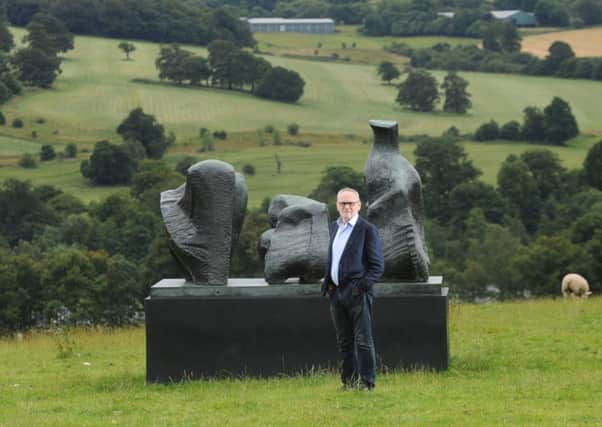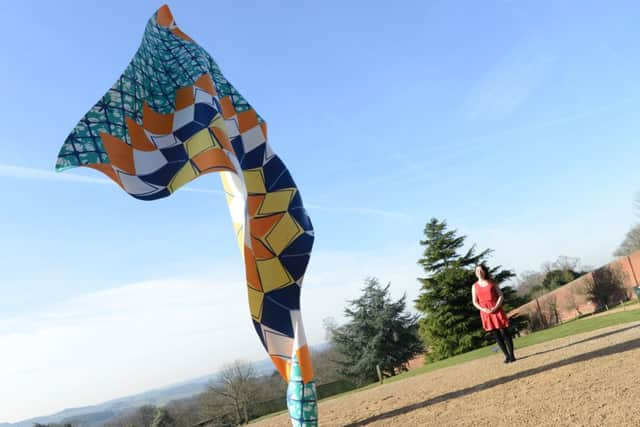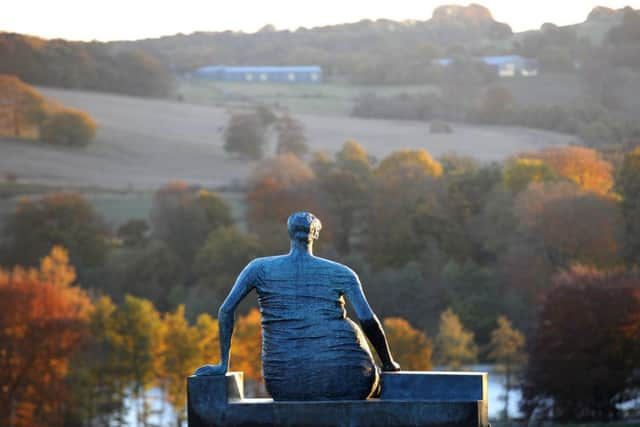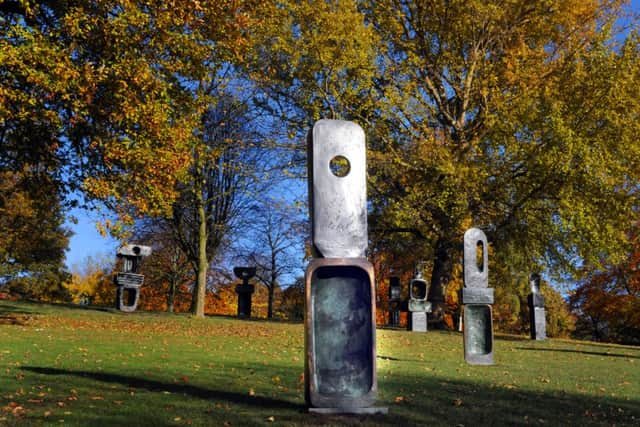Where high art meets landscape


Peter Murray is looking out across one of his favourite views at the Yorkshire Sculpture Park. Just a few yards from the entrance, the landscape is dotted with the giant cedar works of Ursula von Rydingsvard. Beyond it’s all rolling hills and in the distance you can just about make out the estate’s old manor house which will soon be turned into a luxury hotel. The M1 is just down the road, but it might as well be a world away.
“Look at this,” says Peter, who sowed the seeds of what is now the YSP 37 years ago when he was a lecturer at the now defunct Bretton Hall College. “It was designed to make you think you owned the entire landscape.”
Advertisement
Hide AdAdvertisement
Hide AdIt’s thanks to Peter, and a number of others along the way, that 500 acres of land in between Wakefield and Barnsley does now feel as though it belongs to the public. It’s also thanks in large part to him that the YSP was recently named Museum of the Year 2014 by the Art Prize Fund.


Peter is naturally modest, but beating two of the big London institutions – Tate Britain and the Hayward Gallery – undoubtedly made the announcement just that little bit sweeter.
“I know how good this place is, but you can never take these things for granted and it would have been a mistake to think that we were favourites,” he says. “The competition was very stiff and any one of the five could have won, but yes to beat the those two in particular is a very nice feeling.”
Wandering around the park on a warm summer’s day just a few days after the awards do, it has given him cause to reflect on the last four decades. He’s far too diplomatic to say so, but the win was also one in the eye for those who criticised the idea of “plonking” contemporary art on a beautiful 18th century landscape.
Advertisement
Hide AdAdvertisement
Hide Ad“In the early days it was hard. A lot of people made their opposition very clear,” says Peter as we wander down the hill and round to the Underground Gallery set into the hillside. If ever there were proof that the YSP has the best curators this corner of Yorkshire could have wished for, this is perhaps it. “Beautiful isn’t it? What we have tried to do is create something of interest around every corner. We want to keep on surprising people, but we also want to work with the landscape and I think the Underground is one of the best examples from that.”


Inside are more works by Von Rydingsvard. Some are similar to the large sculptures elsewhere in the park, but there are also works made from the lining of cows’ stomachs and various small pieces inspired by her Polish heritage. There are a dozen or so visitors wandering around, but a few hours ago it was a different story.
“This morning we were packed with school parties, but that’s great,” says Peter, as he stops to point out that viewed from above one of Von Rydingsvard’s works spells out a word in Polish. “Right from the start we were clear that this had to be about education. So from the outset we made sure that there was a strong education programme and we got schools in straight away. I think that was key, because quite quickly we saw these children bringing their parents and the next time their grandparents. There has always been a strong family atmosphere and when the award was announced the staff who were here said there was a real buzz around the park, not just among those who work here, but the visitors.”
As if on cue, a couple stop Peter in his tracks to congratulate him on the award. They’re regulars to the park and like many believe the recognition is long overdue. Certainly if there were prizes for sheer persistence and determination, the YSP should have been decorated many times over.
Advertisement
Hide AdAdvertisement
Hide AdThe park began in 1977 when Peter, backed by the Bretton Hall’s principal Alyn Davies, put on an exhibition of 31 sculptures in the college grounds. “We didn’t have an audience and we didn’t have any money,” says Peter. “The only thing we had was a vision. It was a difficult sell. We had to persuade the academic board and the college governors to open up the grounds. There were a whole load of security issues, but they supported us and I guess once we had our foot in the door we weren’t going to let it shut.”


Today, the estate is home to hundreds of pieces by the likes of Barbara Hepworth, Antony Gormley, David Nash, Andy Goldsworthy and Sir Anthony Caro. Some are permanent, but there’s also a rolling programme of exhibitions both outside and within the park’s five galleries. With more than 350,000 visitors last year, it’s estimated the park contributes around £5m a year to the local economy.
“I always thought it had a potential for greatness,” says Peter. “But I couldn’t honestly say that I thought it would get as big as this. Of course size isn’t everything, but I do think we have managed to bring the whole of the landscape together. We pretty much own all 500 acres now, but the work is always ongoing.
“We’ve done a lot of work to restore the landscape to how it used to be in the 18th century. We’ve taken out a lot of the more recent planting to open up the view. It looks lovely at this time of year, but I like it in the fall, I like it in the snow and, you know what, I even like it in the mist, even though I know our visitors don’t.”
Advertisement
Hide AdAdvertisement
Hide AdThankfully when this year’s panel of Museum of the Year judges came to Yorkshire the sun was shining. Peter took them on a guided walk, before they hopped into a four-by-four to see the rest of the park. They left impressed.
“A perfect fusion of art and landscape,” said Stephen Deuchar, chair of the judges. “Yorkshire Sculpture Park has gone from modest beginnings to one of the finest outdoor museums one might ever imagine. In 2013 it really came of age with projects such as Yinka Shonibare’s extraordinary exhibition; the fruits of the expansion and consolidation of the landscape on both sides of the lake; and with the conversion of the chapel to house a major new work by Ai Weiwei.”
The Shonibare exhibition saw 30 works ranging from sculpture to film, photography, painting and collage displayed around the park while the Weiwei installation was the first in Britain since his infamous Sunflower Seeds at Tate Modern. That work had to be closed to the public after health and safety experts warned the dust created by people walking on the porcelain seeds might exacerbate conditions like asthma. There was no such controversy with the YSP installation. In fact, there was something of a fairytale quality about Iron Tree, 2013, a majestic six-metre high sculpture which stood in the chapel courtyard.
“We’ve always tried to create a relaxed atmosphere, we want the park to be an informal place,” says Peter, who the following day would collect an honorary degree from the University of York. “Of course there’s an underlying intellectual framework, but we try to make people welcome, wherever possible we want people to be able to touch the work, to see how it’s made. When we first opened we organised public sculpture workshops. It was partly in response to those who looked at some of our pieces and said: ‘Well, I could do that’. Our response was: ‘OK, come on then’. It really isn’t that easy even to just make something which stands up, let alone looks beautiful.”
Advertisement
Hide AdAdvertisement
Hide AdThe Museum of the Year award is important for two reasons. It not only gives a big boost in terms of profile, but the winner also receives a cheque for £100,000. With arts funding under more and more pressure, the benefits of an unexpected windfall are not to be underestimated.
“There is always a problem getting the money to put on big impact exhibitions,” says Peter. “The transport costs alone can be astronomical, there is no getting away from it, it’s always going to be an expensive operation. But it’s worth it.
“I’m passionate about all art. I love visiting museums and galleries and I’ve been very privileged to have met some wonderful artists, but I think there is something about sculpture when it has space, there’s a really sensual quality about it, it generates an emotional response. It’s like walking around the landscape itself.”
Peter is under strict instructions not to reveal details of their next big exhibition. You get the impression he’s bursting to share the secret, but fears the wrath of the park’s backroom staff should he spoil the surprise.
Advertisement
Hide AdAdvertisement
Hide AdHowever, he’s happy for the moment just to enjoy the win. There are plans for a staff get together to toast their Museum of the Year success and the award will sit next to one which Peter is particularly proud of.
“You know we were named Yorkshire’s Most Magnificent Attraction last year, don’t you?” he says as we wander back to his office. “Most Magnificent, I do like the sound of that.”